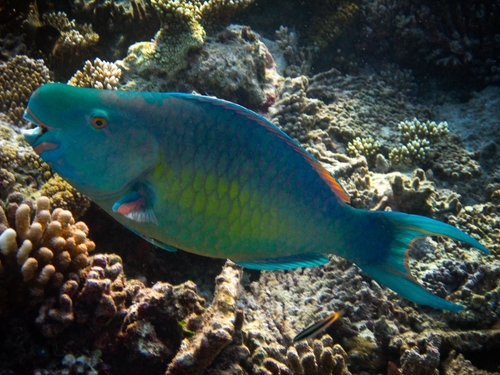With an estimated 33,000 species of fish swimming around in all kinds of bodies of water – fresh and saltwater alike, it would stand to reason that a fair share would have names that start with the letter E.
We’ve taken the time to research these names, finding some of the most popular fish on the planet that have a name that start with this letter.
We spotlight 10 of the most popular below, giving you a little bit more information about these fish, what they’re like, and where they live (amongst other things).
Shall we get right into it?
Contents
Popular Fish That Start with E
Other similar posts:
Popular Fish That Start With H
Popular Fish That Start With C
Popular Fish That Start With B
Popular Fish That Start with T
1. Emperor Angelfish
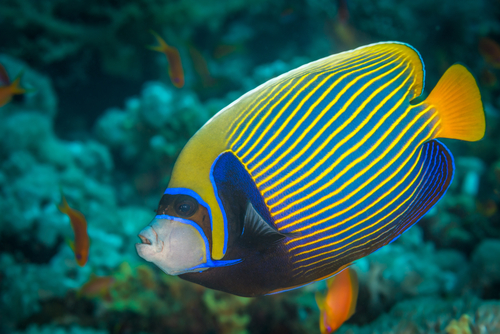
Angelfish are some of the most popular fish to keep in a saltwater aquarium, and for good reason – they are big, beautiful, and (generally) peaceful fish that do not require a tremendous amount of closely monitored care.
Emperor angelfish are a little bigger, a little brighter, and can be slightly more aggressive and slightly more territorial. But they are beautiful fish with a lifespan of 20 years old or older, making them a fantastic investment (even if they are a little pricey) to keep in your aquarium.
Found typically in the Red Sea, parts of East Africa, as well as in the more refilled parts of Japan (as well as along the great barrier reef in Australia), these fish have even been spotted as far away as Hawaii, Puerto Rico, and even Florida – and they do quite well in these waters, too.
Any quality aquarium supply or exotic fish shop should be able to help you land an Emperor angelfish if you really want one, though.
2. Eel
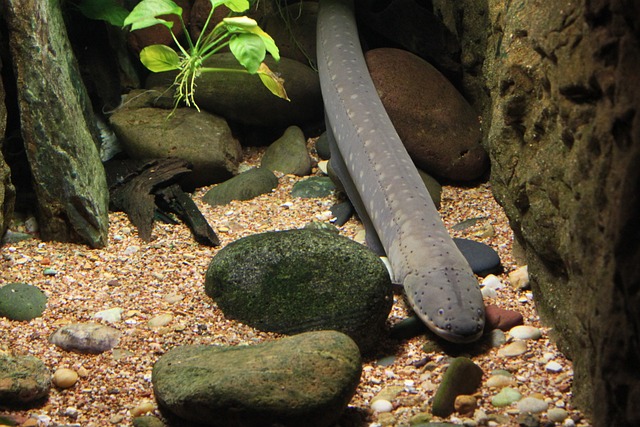
While there are plenty of folks who long believed that eels are closer to underwater snakes than members of the fish family, the truth of the situation is that eels are much closer to rays than almost anything else.
Often narrow, elongated looking fish, these creatures can grow from anywhere to 2 inches in length (like the one jaw to eel) to up to 13 feet in length when you’re talking about the slender giant moray.
There are no pelvic fins on these creatures and often no pectoral fins either, giving them a very streamlined kind of look. It’s not unusual for the dorsal and anal fins on these fish to have sort of “fused” into other fins, either.
Because of this mostly for finless body eels have to swim through the water by moving similarly to the way snakes move over land.
They wave their bodies in one direction or another, and many eels have even been known to reverse course on the spot (and even swim against strong currents) just by changing the direction of their “wave”.
One of the most unique things to eels, though, is that many of the migrating types are able to sort of morph and change from a saltwater fish to a freshwater fish and then back again.
This allows these fish to live and thrive much anywhere and everywhere imaginable, extending their lifecycle out significantly to boot. Believe it or not, it’s not unusual for eels to live to be 50 years old or older. There’s even a story of an eel in the Swedish aquarium living to 155!
3. Electric Eel
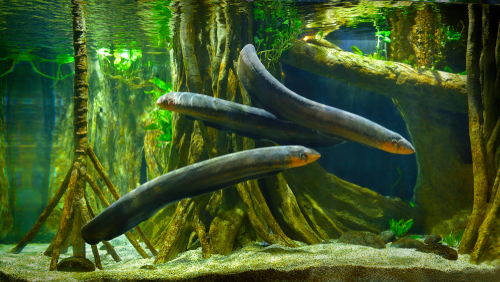
Just like the electric catfish, the electric eel has some pretty “shocking” potential – though the electric current that these fish put out is even stronger than the zapping capabilities of electric catfish.
Generally releasing a powerful blast of up to 650 V on demand (we are talking about five times the electrical power that comes out of a standard electrical outlet in the United States), these fish rule their dominion in the Amazon region – though they (thankfully) do not have a particularly aggressive personality.
Nocturnal fish that love to live in muddy water, these fish can grow to be up to 6 to 8 feet in length and way north of 44 pounds without a lot of difficulty. They generally use their electrical stun power to incapacitate prey that they are going to eat (which generally means smaller fish).
It’s kind of incredible that this electric stun doesn’t do more damage to the fish that get hit by it. In closely monitored tests, researchers have been able to use the stun of an electric eel to knock a horse clear off its own fee!.
4. Elephant Fish
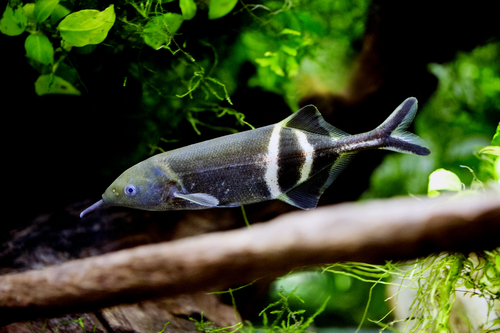
One of the goofiest looking fish on our planet, the elephant fish has almost no scales whatsoever and a big, long elephant-like nose upfront, with some pectoral and dorsal fins that kind of make this fish look like a baby dolphin.
Generally found in the lakes, ponds, and rivers of Africa, this freshwater fish has quickly become a favorite for those that maintain home aquariums.
While these fish are pretty friendly with other different species of fish, you’ll want to be sure that you are keeping your elephant fish as a “solo operator” and not mixed in with another of its species. That’s how territorial fights break out and it’s not a pretty sight.
Just make sure that the water you have your elephant fish and is slightly acidic, dialed into the right temperatures (between 73°F and 82°F), and that you are working with at least 50 gallons of water or more.
5. European Minnow

The European minnow (sometimes called the common minnow) is a very small species of carp, a fish that will only ever grow to a maximum length of about 5.5 inches – though it usually grows to be considerably shorter in length than that, even.
A big lover of cool waters, you’ll find these minnows in lakes, ponds, and oxygenated large rivers when water temperatures hover between 54°F and 68°F. These fish shoal together in giant numbers, giving themselves better protection from predator attacks.
These fish (generally) aren’t kept as pets but instead are used a lot in the commercial and sport fishing industries as bait fish.
6. Eagle Ray
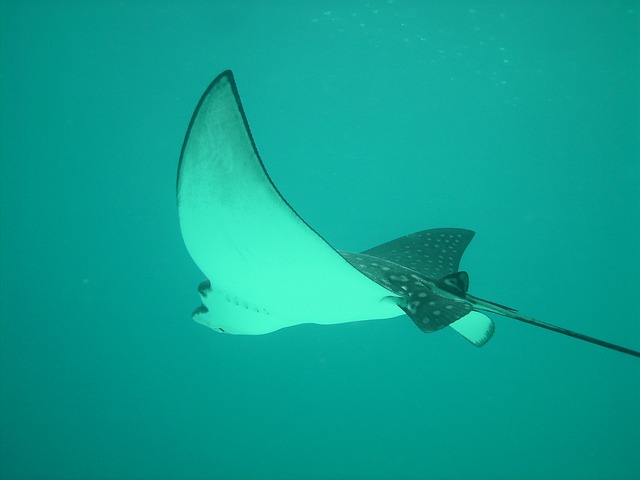
The Eagle Ray is a species of fish that loves to live on the open ocean waters, unlike some of the other members of the ray family that like to stick a little closer to the ocean bottom.
Typically found in the eastern part of the Atlantic Ocean as well as throughout the Indian Ocean, the Pacific Ocean, and the Mediterranean Sea, these fish grow quite large – sometimes up to 6 feet in length (when you include their tail, of course).
One genus of this species – the Aetomylaeus – has no “stinger” on their tail, quite distinct from most of the members of the ray family (including the rest of the Eagle Rays, too).
Incredible underwater athletes, the Eagle Ray is named so because they have the unique ability to breach the water kind of the way that dolphins do – leaping feet out of the water and sort of gliding along before they return back to the ocean.
7. European Flounder
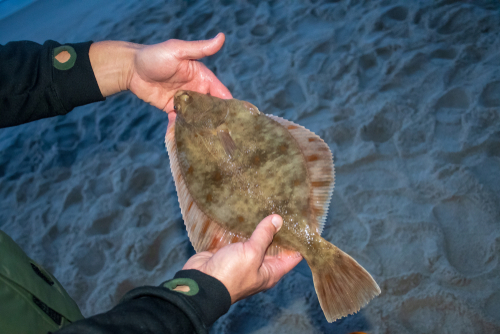
Native to the northern part of the eastern Atlantic Ocean, as well as found throughout the Mediterranean Sea, these fish have either been caught and intentionally introduced into the waters of Iran, the White Sea, the Baltic Sea, as well as the Black Sea.
A seabed theater, this flounder flips sideways and sort of vacuums up food directly from the ocean floor and in the water column that hovers just above it.
This means these fish usually consume shrimp, worms, and tiny mollusks as well as small fish, giving them quite a bit of meat and making them a relatively attractive target for the commercial fishing industry.
8. Electric Catfish
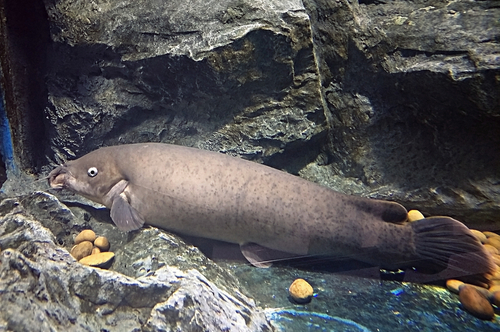
With so many different kinds of catfish on the planet today it takes quite a bit to stick out from the rest of the pack (so to speak) – but the electric catfish does that almost effortlessly.
Natively found amongst the slower moving waters in the Nile River as well as the Niger River (and some other larger river systems throughout the central and western parts of Africa), this catfish has the ability to “zap” other fish in the water that it plans on eating!
The electrical charge that the catfish puts out is relatively subdued compared to the kind of charge the electric you’ll put out, but it’s still going to be quite painful if they bump up against a human!
We’re still talking about 400 V of juice being pushed out by these catfish on demand, after all.
These fish are about average size as far as catfish go – growing to be about 3 feet in length – but because of their exotic nature there are a lot of people around the world that want to keep them as pets in their own aquarium.
That’s not recommended for a variety of different reasons (not the least of which is it wouldn’t take long for electric catfish to stun and eat all of their tank mates), but the sheer amount of water that these catfish would require – 100 gallons or more with a strong current – dissuades a lot of people from this, too.
9. Escolar
The escolar is a bit of a unique fish, a fish that has a number of different aliases depending on what the fish is being used for.
Sometimes called a “snake mackerel”, this fish has a very long, very slender kind of body. It really looks a bit like a sardine that has been stretched to almost unbelievably long lengths in the middle.
These fish are often found near larger schools of tuna fish, not necessarily because they want to be there – but because the tuna love to feast on them!
Unsurprisingly, that means that a fair share of these fish get caught up in tuna longline commercial fishery operations.
Instead of tossing them back, though, these fish usually get processed at the same kinds of facilities that handle traditional tuna and they get sold as “super white tuna” – though they really aren’t tuna at all!
10. European Perch
A massively popular fish for anglers to target, these fish love to swim all over the fresh water basins in Europe. Relatively abundant, these fish have even started to penetrate into the more brackish water of the Baltic see and continue to expand their natural habitat year after year.
A predatory species of fish that feed on other fish (including young European perch), the aggressiveness and territorial nature of these fish are a big part of their appeal for anglers.
It doesn’t hurt that these fish taste fantastic as well, with commercial operators starting to get in on the action. Russia alone fished 15,000 tons worth of European fish in 2013 and the number has only increased year after year.
65 More Fish That Start with the Letter E
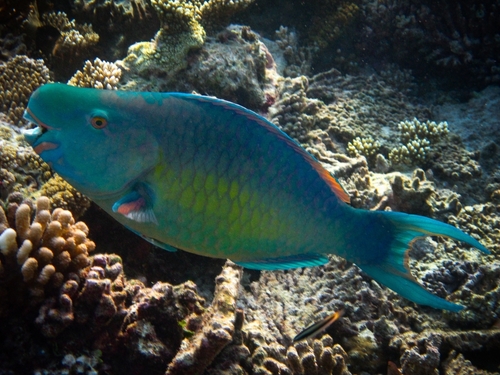
1. Eel Loach
2. Eastern Spiny Gurnard
3. Edible Gourami
4. Eastern Spiny Seahorse
5. Eastern Banded Catshark
6. Easter Island Flying Fish
7. Ebinania Brephocephala
8. Eastern Cleaner-Clingfish
9. Eelpout
10. Eel-Goby
11. Ebomegobius Goodi
12. Eastern Clingfish
13. Emperor Bream
14. Eeltail Catfish
15. Eastcoast Squeaker
16. Eastern River Garfish
17. Eastern Silvery Minnow
18. Eastern Bream
19. Elephantnose Fish
20. Eastern Paradise Fish
21. Ember Parrotfish
22. Ecuatorial Ray
23. Espe’s Pencilfish
24. Eastern Spotted Gummy Shark
25. Earth Eater
26. Eucla Cod
27. Ethiopian Lungfish
28. Eight-Barb Loach
29. Electric Ray
30. European Chub
31. Empire Gudgeon
32. Emerald Catfish
33. European Wels
34. Elver
35. European Eel
36. Emperor Tetra
37. Ebinania Macquariensis
38. Eastern Rainbow Fish
39. Eastern Bottlenose Mormyrid
40. Electric Knifefish
41. Eastern Pomfred
42. Ebinania Malacocephala
43. Eastern Mudminnow
44. Eastern Australian Legskate
45. Elasmobranch
46. Eel Cod
47. Easter Damselfish
48. Ebinania Costaecanariae
49. Elegant Rasbora
50. Eulachon
51. Electric Yellow Hap
52. Eastern Blue Devil
53. Elephant-Nose Cichlid
54. Entsuyui
55. Earthworm Eel
56. Elongated Lepidiolamprologus
57. Ebinania Vermiculata
58. Eastern Australian Blackhead Triplefin
59. Eastern Smooth Boxfish
60. Emperor
61. Eye Spot Loach
62. Everglades Pygmy Sunfish
63. Egyptian Mouthbrooder
64. Eye-Lined Pyrrhulina
65. Eastern Starhead Topminnow

Ian Sterling, founder of Fishlab.com, began his aquarium journey over 30 years ago, driven by a deep fascination for fish and their diverse personalities. His website, Fishlab.com, is dedicated to making fishkeeping accessible and enjoyable, offering beginner-friendly guidance, expert insights, and a community for aquarists to connect and share experiences.


